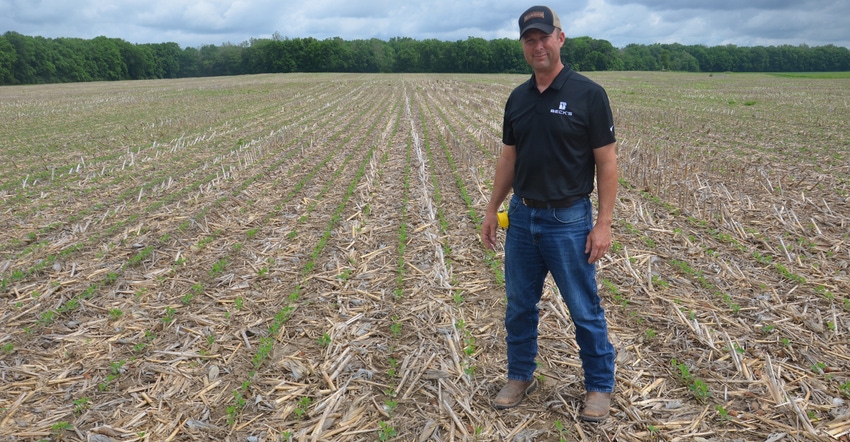
You went through your planter already, replacing parts that were worn and putting it in top condition. If you had not added upgrades before, maybe you’re adding technology that should help you pick off low-hanging fruit for improving corn stands and yields. Perhaps that’s row shutoffs or vSet or even electric meters.
What do you look at next if your goal is obtaining the best stand possible while staying within your budget?
Several farmers and agronomists discuss how they have tackled this question, and what they would tell others. It should become evident quickly that the answer varies depending on your individual situation. Here’s a closer look:
Don Villwock, Edwardsport, Ind. Villwock and Jason Misiniec farm in southwest Indiana on a variety of soils. They switched to Precision Planting eSet units a few years ago, and still like the performance. Then they turned to some relatively inexpensive options.
“For us, it was notched closing wheels with a twisted drag chain,” Villwock says. “Our soil types range from clay to blow sands. In our bottoms, we go from silt loams to tighter zip soils, all in the same round. Plus, we’ve learned that you can’t wait for ‘perfect’ conditions to start, and the notched closing wheels make planting through small, marginally wet areas more forgiving.
“Probably the cheapest but very effective add-on was seed firmers. Today, I would add a seed firmer that allows for placing fertilizer in the furrow or below the seed.”
Villwock has no-tilled for 40 years. “We really don’t need a coulter out front,” he says. “This is especially true if you have floating row cleaners. I don’t think we have ever had soils in the spring hard enough to justify a coulter. Row cleaners provide a critical, clean seedbed area. Coulters are an expensive option, and anything with a bearing and a blade is a potential high-dollar maintenance item. I would eliminate coulters and spend money on floating row cleaners.”
Roger and Nick Wenning, Greensburg, Ind. The Wennings no-till and prefer planting green. However, their first objective when converting a new farm to no-till is developing a healthy soil. Then they plant with a Great Plains 12-row-wide, twin-row planter.
“We have row cleaners, but we don’t have coulters out front,” Roger says. “We don’t need them. About the only thing we’ve changed on the planter is switching to curved-tine closing wheels.”
Carter Morgan and family, Cayuga, Ind. Replacing worn parts and thorough maintenance top Morgan’s list. If you don’t have row shut-offs or perhaps electric meters, address those issues. Then he’s ready to move deeper.
“The next thing I would look at would be rubber closing wheels,” Morgan says. “There are thousands of combinations of closing wheels available, and they each serve their own purpose in different situations.
“I am a Case IH planter guy, so I think the two-stage closing system is second-to-none.”
There are several aftermarket options that can be added to any planter now with a very similar setup, he says. He adds that Precision Planting has taken it a step further with the FurrowForce closing wheel system. He believes it is a little more aggressive, and it can be controlled remotely.
If you don’t have starter fertilizer on the planter, Morgan suggests looking at it. His family’s planter is equipped to apply starter. “I would keep using starter fertilizer because I know it pays,” he says.
Steve Gauck, Greensburg, Ind. Gauck and his family also farm wet, variable soils. He’s a regional agronomy manager for Beck’s. After emphasizing taking care of maintenance and all the basics, he suggests starting with closing wheels.
“The closing wheel is at the rear, so it’s the last thing on a planter pass that could affect stand,” he says. “So, when it comes to upgrades, I always start with closing wheels. Any aftermarket wheel is better than the standard rubber closing wheel. Whatever unit you’re using, make sure the closing wheel tail is lined up properly and is tight.”
Gauck also encourages growers to focus on seeding depth accuracy. Don’t assume every row unit is placing seed at the same depth, even on a new planter delivered from the dealer, he insists. Take the time to check actual seeding depth on each row before going to the field. This is also where hydraulic downforce can provide help, he says.
Bob Nielsen, Purdue University Extension corn specialist. After thoroughly inspecting the planter and replacing worn parts, Nielsen suggests addressing specific challenges you have while planting. For example, does the planter frequently have difficulty penetrating the soil and placing seed at uniformly acceptable depths?
If so, he sees several potential options for solving the issue. It could mean installation of functional row cleaners and/or cutting coulters, if you don’t have them on the planter already. Or it may mean manually adjusting the height of the row cleaners based on field conditions the day of planting. Your goal would be most effectively moving surface trash ahead of the double-disc openers, he says.
Perhaps you could solve it by increasing the row unit down pressure manually across the board, based on soil conditions the day of planting, he continues. Or this could be where installation of auto-controlled down pressure technologies might help, he adds.
Editor’s note: This is the final part in a four-part series about upgrading your planter. Don’t miss the previous stories, Refresh your planter before investing in add-ons, Row shutoffs, electric seed units make good planter upgrades and Seek better stand establishment with planter upgrades.
About the Author(s)
You May Also Like




